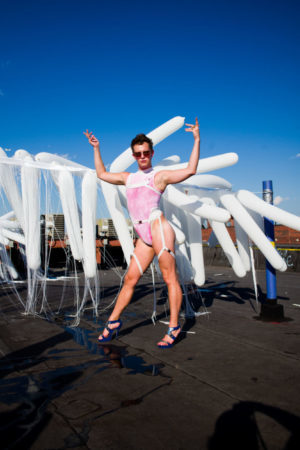Tyler Ashley: … And that’s a huge part of what you said when you asked me these questions in your email, when you brought up social media, it’s a huge part of this conversation. There’s a huge part of what don’t you see, when it comes to nightlife, I like the terms you used, “social scene”, “lifestyle”. In these images, what you see is what I’m wearing at the club, you see the DJs, then you see me filling in the gaps with other images, pictures of this party idea, of what I’m doing through social media at the club. Posting photos from the event that you either attended or didn’t. What hashtags am I using? How do I categorize the post? There’s a trail that links the event, down to silly things about when I post about an event and really asking what exactly I draw attention to and how do I say it; is it lengthy, shorter, punchy?
Mariana Valencia: So those are basically the questions, I’m here with Tyler Ashley a performer in many capacities, I think my first encounter with you was through your work with STREB, which you can speak to but you don’t have to, there have been other artists you’ve worked with too. I’m interested in the way I’ve come across your work recently, over social media, this work in nightlife and lifestyle. I want to talk about Tyler Ashley and Tyler Ashley. I’m interested in this character and the cohort of characters who travel about town with you. Who do you dress up for? And why? I’m interested in the symbology and language that carries this scene for you through social media and how that canonizes the form for you and your social media footprint. How does Tyler Ashley function in a month, in a day, personally and publicly?
TA: It’s helpful for me to start from, I came from a small town, I was singing and acting musical theater style in a chorus and then I played sports. I was weary of going into performance in college because being from a small town I knew of the big fish in a small pond phenomenon and I was nervous. I thought “I’m not gonna get into a musical theater program at these schools” I wanted to stay creative but you know, make money from creative practices, blah, blah, blah, so I came up with advertising. And I like advertising –it’s about messaging, messaging, messaging… and really what I realize now, I’ve always been very curious about advertising.
MV: Really, you’re employing it now still…
TA: Totally, and so I went to Emerson in Boston for marketing and really it was during my junior year, something that stemmed from high school stayed with me: I was an overachiever… and you know, I got the “Outstanding Marketing Award” at graduation and was a member of all these organizations and simultaneously, I discovered dance. That was one of my biggest life “Ah-ha!” moments because it was finally this marriage of physical activity with athleticism, creativity, imagery and openness that really had nothing to do with singing about the love of a guy and a girl…
MV: Right, you could be abstract you could rest within the inbetweenness of your expressivity.
TA: I finished the degree but my goal was to come to New York to dance.
MV: What kind of dance did you find at Emerson?
TA: You know, Emerson… it was modern, postmodern, I took Humphrey/Weidman, a little Graham, maybe one Jazz class. Emerson had composition with a crazy woman, who was amazing, and through dance history I first heard of Elizabeth Streb and they were coming to Boston but I didn’t get to see them, I didn’t have a ticket. They were sold out at the ICA. So once I came to New York I said, “I’m going to get into dance” I got a job as an usher at The Joyce, and an internship at Dance Theater Workshop, shortly thereafter I got a few part-time jobs at both Dance Theater Workshop and The Joyce and shortly after that I started interning at STREB. It was an admin internship and I was to organize their archives. I started training and teaching children at STREB and then I was invited to audition for and finally perform on a part-time basis and that was five years of working in that capacity with STREB. Literally at the same time I started working with STREB, I started working with Walter Dundervill and Larissa Velez-Jackson.
So that was my entry point and I began making my own work. Which has always been this meeting point of what I think is dance theater, postmodern and performance art, which a lot of people identify with right now.
Having said all of that…. I’ve always enjoyed to go out dancing, drinking and being social, and moving to New York was like… “Oh thank God I didn’t start out here” you know as a 19 year old I would have really gotten myself into trouble, as sleepy and annoying as Boston was I really think it reigned me in a little bit. Because when I came to New York (makes explosion sound), my head exploded… While everything was developing for me on a professional dance level, I was falling in love with nightlife in New York. At that time, I was coming into the end part of the regular Sunday nights, that have really been an important part in the gay world. The Sunday night has always been a big thing in the gay world, “Sunday Funday”… Like, “when do normal people go to bed and gear up for the week? That’s when we’re out and we’re like…That’s how we do the beginning of the week!” (laughs)… You know stay out late…
MV: That’s how we start the week… (laughter) That’s how we face the week…
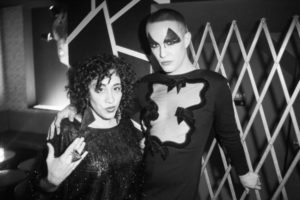
Photo By Gerard Garvey
TA: Yeah and you know there used to be gay stuff happening more regularly attended throughout the week starting on Sunday night and now it’s more the basic Thursday, Friday, Saturday the way the rest of nightlife is though there are events that stray away from that. I was going out a lot and I just LOVE nightlife and the whole freedom and pushing a limit of excess and mystery because of that idea of you only experience these people when you’re at that night for those few hours and remember, this was within the first three years of Facebook. That’s when I was entering all the nightlife stuff and we know from that point, I graduated in 2007, moved to New York and we all know the trajectory of social media from that point… it’s exponential…
MV: Yes
TA: My solo work has pulled from my experiences of night life ideas, of debauchery and excess but with repetition that pulls from postmodernism. I use ideas from nightlife as tools to pull from into my creative dance work. What came from that is Baby Tea, my monthly party. I’ve tried to have it teeter between an amateur quality with some sort of faint format, but it can still be what I want it to be. So that no one has a necessary expectation of it each month but for the most part it’s listening to good music, seeing people you want to talk to and hang out with, probably have a good laugh and a good drink. I finally decided to start my own party after three or four years of spending time out on Fire Island with Tea culture. You know the big gay Tea Dance culture.
MV: Were you familiar with Tea Dance culture before Fire Island? Had you participated in it yet?

Photo By Lucas Blair
TA: Not in this way. No, because really clubs are nightlife, I could guess it exists on Fire Island because, you know Tea culture comes with leisure… dare I say… (MV: an afternoon needs to be available) Exactly, so that you can take… you know, they were modeled after French and English tea times, you have your little sandwich triangle/square and drink tea and talk, whatever. What I loved about it was that the expectation was low. It was about listening to your favorite DJ in the sun there was something very simple and pure about it, as far as what actually happens at the tea dances. Some had drag shows and stuff but not all of them. Baby Tea was modeled after that and a monthly party called Mattachine that takes place at Julius Bar, the oldest gay bar in New York City.
MV: Yes, one of my favorite places… (TA: I know right?…) also what a good burger, the best five dollar burger in town.
TA: Yes a five dollar burger…
MV: So Mattachine, the party…
TA: Mattachine is a party by John Cameron Mitchell and Amber Martin, and they played really good throwback music, disco and seventies and it is the first Thursday of every month. Their slogan is something like, “good people, good music” and I modeled Baby Tea after those parties. I was lucky to do it at dancers Jessie Gold and Elizabeth Hart’s bar that they had on the Lower East Side called Cafe Dancer. I did it once a month and it evolved, I didn’t always choose DJs, I thought about it more as who I wanted in control of an ipod at a house dance party, so that really opened up to creative people.
There were no shows, I’ve found that in and outside of nightlife, performance is just so much work for so little pay or no pay that I said “No performances!”. If someone wants to give an impromptu show or if I want to, fine, but there is no one working for that. Really just drinking dancing and hanging out with your friends. We could have it be an after party for a choreographer’s premiere, I made it into a fundraiser for FIERCE NYC, a group that’s an LGBTQ youth group by membership, that does a lot of programming to service queer youth of color in NYC. I called that party Baby Tea for T, and that was money earmarked specifically for trans youth, I’ll do that again this fall.
We might do a fashion week Baby Tea to launch a bag line for an artist who used to work with the fashion collective ThreeAsFour. Baby Tea became a malleable thing, it could travel, I did a roving version at Art Basel, where I said “I’m just going to tell you where I’m going and that’s where Baby Tea is…” (laughs) and we had a lineup of four parties that we went to that night and it didn’t really work but you know, just thinking about it in that way…

Photo By Gerard Garvey
MV: Which already breaks the mold, you say it comes from nightlife and it comes from Tea Dance culture that you encountered on Fire Island, but it’s also yours, it’s the new version. Not necessarily a dismantling, but it is a new occupation of it. You’re occupying it at Basel in this way and shaping it this way here, it’s for someone’s after party, a fundraiser for trans youth, it also happens just because, and it’s not necessarily about anything in the scene that it might be bound to. It’s not sloppy, it’s meaningful, perhaps casual is not the right word but what I can sense is that it defines honesty. It’s not so much punk but it’s raw, absolutely on time, current, for the people who show up and it’s immediate, to me, this is what keeps it nuanced. Which I think is why you’ve kept navigating this Baby Tea so openly.
TA: Part of that is that the people are different every time— for what reason do they arrive? How do they wanna use Baby Tea when they go to it? I think that’s the through line of this word I always come to which is “Amateurishness”. I don’t want to use it, but I have yet to find the right descriptors, those words you listed just now are exactly it. I think it might come from my desire to be honest, with this concept that I call the Dauphine of Bushwick, which I’ll get to.
This came from working creatively in the dance world, Larissa always talks about the performance of failure and valuing it the same as achievement. Walter Dundervill completely shows the creation of a world and lets it transition into another world. Elizabeth Streb says, “I’m not hiding the forces here” so creatively I’m interested in an honesty too. This is where I’m at in my life and this is the time and the money and energy that I have to give to something that I want to do. Without hiding from the realities of what I can put into it. So yes, it is a little messy and rough around the edges and raw, glamorous with a dirty ….. (MV: a little like “I didn’t get to that yet”…)
Yes! It’s part of the title, Baby Tea. It’s a little premature and that’s fine because it celebrates, messiness and shows itself as it figures out it’s trajectory. That’s why I’ve never said that I’m a drag queen or trying to be a drag queen. And I always make this very clear, out of complete and utter respect for people who are drag queens. I’m not trying to sell a fantasy that’s convincing, that I’m female, I’m woman. More so this is some type of performance that off settles energy that captures your attention through the use of some drag elements. I use makeup, I am in heels, it is a feminine persona, but I don’t really wear wigs (just every now and then) I don’t tuck, I don’t pad. I don’t really have a name, to me it’s not really a character, it really is an extension of myself or I should say I throw some steroids into this side of myself that goes over the top…
MV: As one side of the spectrum of yourself.
TA: Yes, really, when you were talking about Tyler Ashley and Tyler Ashley, in my mind it’s Tyler Ashley and Tyler Ashley, The Dauphine of Bushwick…. And where that came from was Sofia Coppola’s film Marie Antoinette.
MV: Oh yes, a great visual…
TA: Great visual but if a man had made that movie it would have not nearly gotten as much flack as it did. But it got so much flack for the inaccuracy of the storyline. I think everyone really missed the point with that. The point was to glamourize this wild story that Sofia was very clearly depicting in a storytelling type of way, not from a historical, factual type of place— I was drinking rose with Ben Kimitch while watching the movie and the line goes, “you better have that baby because you’re The Dauphine of France”— and I thought, “The Dauphine of Bushwick…” I felt like I related. You know, they weren’t ready for what they were set out to take on, I felt similarly, I wasn’t ready to take on all this dance career, but I moved here and felt like I was a part of this little renaissance and I took part in it all.
I was in the dance and performance world at the time RuPaul’s Drag Race exploded. It was a part of a movement. In Bushwick, there were so many new creative people —and this is with sensitivity to the gentrification that it took part in— but really I like to always stress this, in social media or anywhere, “We’re all The Dauphine” we’re all in this new territory together. This Dauphine title doesn’t really have a direct translation, but it means heir apparent. A good example is the Princess of Wales, Princess Diana was the Princess of Whales which means she was the heir apparent through marriage, and that’s what Marie Antoinette was by being The Dauphine, she married into royal court. There’s ways you can screw it all up, apparent isn’t a given. If Marie Antoinette hadn’t have had the children and France sent her back to Austria, she would no longer be the heir apparent.
There is this link for me to the Dauphine of Bushwick where there is a cusp, the whole situation has to maneuver gentrification and why people continue to move further out. Why are there no more Sunday Parties in Manhattan? Why are those clubs being turned into luxury condos. So there is this idea of heir apparent where we’re coming into this situation and address it with our art and our actions. The Dauphine of Bushwick through Baby Tea is about that kind of uncertainty and about lubricating our ideas together.
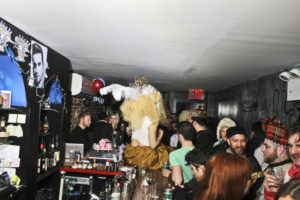
Photo By Gerard Garvey
MV: Yes, and it’s an experiment of something that’s inside and outside of an existing entity. It doesn’t adhere to any one thing. I keep coming back to this but it feels like Baby Tea is really fluid, yes you’ve attached yourself, Tyler Ashley to it but within that there is freedom too. It identifies you and that identity is open or bound to change. I think these three attached titles, the Dauphine of Bushwick, Baby Tea and just you Tyler Ashley, they’re connected to art and dance in similar ways that Larissa and Walter have been in your life. Ideas come together and fall apart, I believe that you’ve found a way to fuse culture.
TA: Before these past two years, I was just doing my job at New York Live Arts and I’d try to explain what Baby Tea was like to my dance peers and people from my job. I’d say “Don’t try to know the story, or the message, just sit there and take it all in and see what your feelings are” There are experiences to the music, a cold chill to a song, a sexual feeling and inner experiences that can’t be labeled. With Baby Tea I don’t always want the same expectation. It will turn some people off to feel uncertain at Baby Tea, but I work to embrace that the unknown, something that can’t be labeled. A lot of the elements come from my experience of dance in a studio, so much of it is improvised and we often don’t know what will come of it all and that aspect of creativity as the center of a nightlife setting is what drives me to do it.
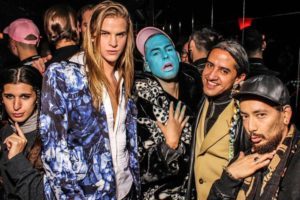
Photo By Gerard Garvey
MV: These elements are in the solo you’re working on, the slow dance, there is something so social, it’s a cannon, it’s binary but also just a gesture of two bodies coming together to slow dance. It’s visually familiar, when you have us see you enact this social gesture, it completely dismantles your nightlife persona and we get to see you have a very personal moment in front of your public. The slow dance is reachy, it asks someone to participate and collaborate with you but once that’s agreed upon it’s about no one else but your intimate experience. The willingness of the person you ask to dance with you exposes the softer side of this nightlife and it’s so earnest, quite soft it reaches out but holds itself intimately and it’s so touching, it crosses social borders. It holds the nightlife symbol in a completely different light of sociality. Like the slow motion love scene in a movie. And you navigate awkwardness and humor, you ask the participant to help you get in and out of your clothes it’s funny and then the intimacy is over. My last question is how did you find this mode of communication? How did you start the slow dance research, it’s stunning.
TA: Thank you
MV: When I asked you to talk about Tyler Ashley I didn’t know you were exploring this and then I saw it in Detroit and I thought, “this is the direction where Tyler’s research is going and it’s brilliant”.
TA: I’ve just come to this decision at this juncture, where I’m discovering this research and I’m deciding to change Baby Tea this fall actually. I don’t think it will be a monthly, it will be something less frequent and it will be two years old in November. I’m feeling my life needing a change, perhaps it’s less nightlife… it’s just getting to be too much to have a full-time job, rehearsals on top of it and then nightlife on top. It’s just too much and the last two years it’s been even hard to find time to sleep. I don’t know if I want to get married and have a baby, but I do feel a change coming on.
I’ve been making these dances exploring nudity, self image, community and duration, repetition, athleticism… and that’s been my dances, as I pull out of nightlife, I want to hold on to what I love about it and I’ve always been inspired by nightlife so I’ve found a way to really directly reference those influences. I see a lot of this in the use of a mic. I am looking into the mic to improvise and as a tool to ramble with. With less of “I am. This is. We are” but more of a loose structural improv. On a mic it’s not like dance duration, it’s like five to fifteen minutes because in nightlife, no one likes to sit and listen at the party for that long.
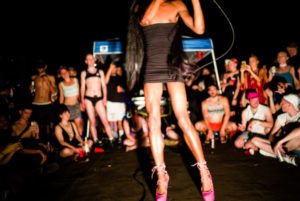
Photo By Victor Jeffreys
MV: This gesture of the nightlife mic— you’re there to entertain us and also to throw me under the bus and yourself under the bus and were going to have a good time— with laughs and truths. We’re all going to engage in a participatory role but it can’t go too long, otherwise it would be a symposium. So the exchange is navigated by sharing the load of the mic socially. A give and take.
TA: There is a skill on mic there is a label in nightlife where we say “She’s a mic queen, she’s not a mic queen”. But in this work there is the mic, the drag, the fashion, and the pop music. The solo in Detroit felt strong.
MV: In Detroit I was taken by this. Yes, you started on the mic you gave us a word, but then you were off the mic and you were whispering or speaking off-mic with your slow dance partner and it was about holding space and care together. Tell me about that experience. Was it about simply slow dancing without a mic? Were you thinking about showing the intimate side of yourself as a body next to another?
TA: I took myself off the mic because the slow dance became a way for me to explore the politics around the body— I mean, who isn’t talking about that, I am too— I was thinking about judgement placed on the nude body and my mom in my ear saying “Why do you have to have your naked body online” and me responding “It’s just a body, mom”. I say, there can be power taken away from the body and really see it as just a body, but the reality is that it really is never just a body. No one just looks at a body and only sees the form. During the slow dance I intend to take the moment to interact with these people and really ask them about the body. About what it means to them. I start it off with “What do you think about elbows?”
MV: Is that what you’re talking about?
TA: It develops and grows and the conversation changes about you know, the politics of Detroit but the focus is to navigate really honest conversations while asking questions about the body during the slow dance. So that’s what we’re talking about during the slow dance. As I step out I see the social and slow dance more clearly after seeing the video. There is laughing and body language whether we wanna dance middle school style or wedding style, really close. And really identifying these iconic imageries.
MV: They’re epic, a memory to everyone. I don’t care who you are.
TA: True, so true. I don’t know what this is yet, but I’m most curious about the feeling of the audience members watching the slow dance, after I’ve proposed something kitschy and then taking it to a vulnerable moment for everyone. We’ve all had slow dance moments, whether they’re about not being asked to dance at the middle school dance, or whether you’ve been married or divorced. It’s simply knowing and recognizing the intimacy in social space. It transports you experience and memory at the same time.
MV: It’s a strong visual because of each person’s experience of that social moment, of the slow dance; a connotation. I’m drawn to its ceremonial event, it proclaims the start of something in our society. It makes sense that your personal trajectory is leading you in this way and that you’re cutting a few avenues for yourself but you’re really finding a way to synthesize the artistic gestures that move you most. Here is where all the meat comes together, a way for you to consolidate. All your best things come together through quality of composition rather than quantity. Would you ever do a group slow dance?
TA: I meant to do that in Detroit, during the last song of the set, I intended to invite everyone to join in a slow dance. I didn’t do that because I had to introduce the fashion show right after, but I intend to try it one day. I think you’re right in terms of consolidating. The thing with nightlife is the fast cash and I love that part. But as thriving as dance is in New York is, it’s still a whole bureaucratic scaffolding, and there are reasons why it’s there but I don’t always think it’s necessary and I don’t always need it there. There are systems in nightlife in place but it’s less rigid.
MV: Nightlife is invitational, it only thrives by having people show up and you inviting them. Bureaucracy works as a different system where you can feel included but it’s up to someone else opening their entrances as you enter through their thresholds.
TA: Thank you that’s a beautiful way to put it because if people don’t show up to nightlife, then it doesn’t exist. It has a hard time if the bar, the DJ and the promoters aren’t making money. It’s more agile in that way too. It’s a community of messaging the cohorts it’s in the same way that we have mentors in dance there are mentors in nightlife. There are drag mothers, someone who teaches you how to do makeup. Someone to learn how to throw the parties from, Horrorchata is a big one for me and really talented. She throws Bushwig, and though nightlife is being pushed out of Manhattan it really is thriving in Brooklyn. It’s thriving where the creators are living in the less posh areas.
MV: That’s good to hear because I often feel like I’m left wondering where everyone with a heartbeat lives in New York.
TA: What I’m trying to do with the dance work and the mic and the Baby Tea, and my rooftop party, where I don’t actually perform– It all appears egocentric but really the message is that this is for all of us and I do this because I want to use what I have to bring us all together. That’s my big idea with the parties. I’m finding a balance of holding an audience and really having them participate.
